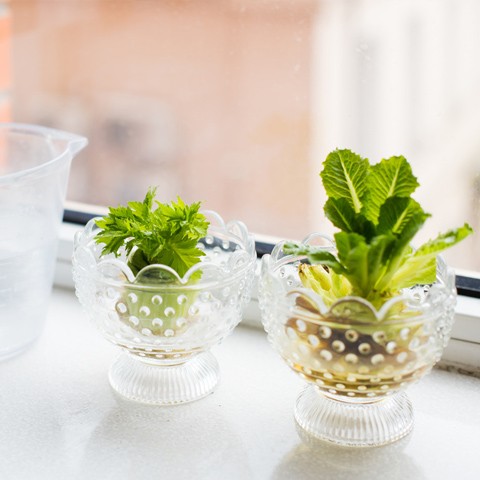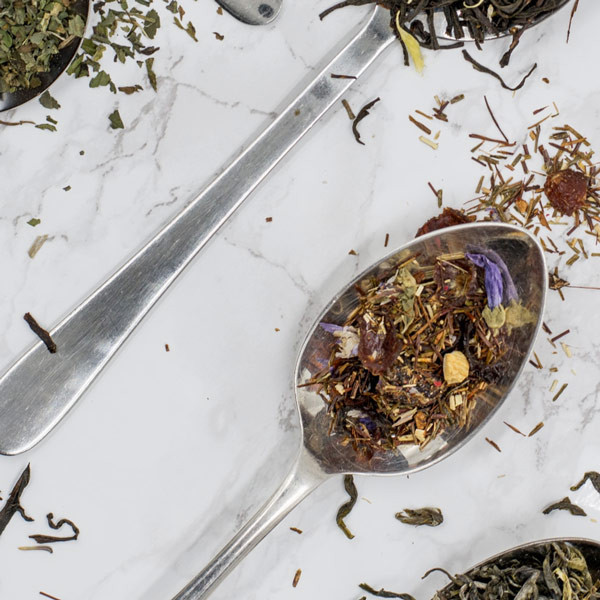One of the key lessons I learned from my parents was how to make the best of everything. How to recycle stuff. The perennial glass on the kitchen shelf, with a sprig of herb or plant placed in a water-filled container to encourage root growth was a permanent fixture and has become an abiding memory. Recycling, reinventing and regrowing was a key part of growing up and a lesson in economics that I can now pass down to my kids.
It’s common sense to try to cut down on our food bills. Feeding families is more expensive than ever and any methods to bring down the cost of the weekly grocery bill are part and parcel of keeping household expenses under budget.
Here’s where regrowing from food scraps comes in. Not only does this help stretch the family food budget, growing your own food without chemical sprays ensures a healthy, nutritious store of vegetables for you and your family. Many studies have now linked various health problems which have been associated with chemical-sprayed vegetables. According to The World Health Organisation (WHO) the problem of pesticides for humans is very real. (1)
“...pesticides are also potentially toxic to humans. They may induce adverse health effects including cancer, effects on reproduction, immune or nervous systems. Before they can be authorised for use, pesticides should be tested for all possible health effects and the results should be analysed by experts to assess any risks to humans.” - World Health Organisation
The prudent approach then is to avoid consuming pesticides, fungicides and other chemicals used in food as much as possible. Instead of causing illness, we should get back to the belief that our food is our medicine (to paraphrase Hippocrates).
However even growing your own vegetables and fruit can cost a significant amount of money. Particularly if you buy seedlings or young fruit trees from the nursery. But did you know that you can regrow many vegetables and fruit from the discarded scraps? Some are more suited than others to being “recycled” and we’ve listed a few of these below for you to try.
Potatoes
Good old-fashioned spuds are one of the vegetables most adept at reproducing themselves. However it’s not the potato as such but the peelings. To regrow potatoes you will simply need some of these peelings that contain the “eyes”: the pinkish buds that are on the surface from where the new plant will sprout. Simply plant to a depth of around a finger length beneath the soil and the new sprout will be seen in days if conditions are right. An alternative method is to lay moistened newspaper on the ground, place the potato peelings face up, then cover with mulch such as straw to a height of around a metre. Water in nutrients into the mulch such as blood and bone and compost. The potato plants will push their way through the mulch and the new potatoes will grow underneath the mulch mix. One amazing advantage of this method is you can push aside the mulch and harvest some of the new potatoes before the main crop.
Tomato
It’s easy to grow this perennial favourite from the seeds of the tomatoes you have already used. However to ensure the tomato fruit is a true representation of the original, ensure you plant the seeds from heirloom or non-hybrid plants. There are a number of methods to save tomato seeds, however this one is tried and true! Select an overripe heirloom tomato for best results. Remove the number of seeds you require, wash and dry them overnight. Place the seeds on absorbent paper to fully dry and then put in an envelope with the type of tomato and the date. When conditions are fine, simply tear off the seed with the absorbent paper, place in a pot of seedling mix, water well and plant out when the seedling is high enough.
Lettuce
The base of any good green salad, having a few leaves of lettuce handy is almost essential for lunch or dinner. But did you know that lettuce can be grown from scraps? Rather than wasting the leftover leaves by throwing them away, try putting them in a bowl with a little water at the bottom. Then place in a spot where there is regular sunlight (the kitchen mantelpiece is ideal) and water the leaves regularly with a misty spray. Twice a week should be fine. New roots — along with new leaves — should start to appear in around 3 to 4 days. Transplant your “new” lettuce into loose, well-mulched soil in a warm, sunny position. Repeat the process for endless lettuce!
Celery
Another regrowth candidate. Simply cut the base of the used celery, place in warm water in a warm place with plenty of sun such as a window sill. Replace the water daily. As the outside of the cut base turns brown, it will “feed” new growth in the form of a new stalk of celery in the centre. Plant out in organic potting mix in the garden after about a week when the growth has reached an adequate height.
Coriander, Basil, Rosemary and Mint.
These favourite herbs are also excellent to regrow from scraps. Take a sprig of the leftover cuttings and place in a jar of water in a warm, sunny place. Make sure there are no leaves below the water level. After about a week, you will notice new root growth. When this growth has established itself, transplant into a pot or the garden in a warm, well-drained spot. Why not consider having a large pot outside your front door full of recycled herbs? Not only an essential supply of fresh herbs for cooking but also a great conversation piece and decorative element to the front of your house.
Garlic and onion
If you keep your garlic and onion in a dark, cool place, eventually you’ll find they become soft and new growth begins from the centre. If you routinely throw these out, into the rubbish bin, you’re wasting a great opportunity. Simply leave the onions or garlic in the dark and cool for a day or two until the growth is firmly established, then plant out into the vegetable garden. Couldn’t be easier! Not only will you have a fresh supply of garlic and onion when the plant is fully grown, but the stalks make great spring onions as well.
Mandarin
If you’re the patient type, try growing a Mandarin tree from its seed. You will need to be careful to choose one that grows true to type and the tree will take a number of years before it is mature enough to bear fruit. Remove the seeds from a ripe mandarin. Wash and drain water and place seeds on a paper towel to dry. Store the seeds and plant in spring or early summer. First grow the seeds in a pot in a warm, sunny place and keep well watered. Plant out when large enough.
Avocado
The avocado seed is usually the first to go in the bin as you take out the delicious flesh. However this can also be used to regrow this nutritious fruit. Simply suspend the seed over a glass of water using toothpicks — the water should only cover the bottom couple of cms of the seed — place in a cool place and add more water if necessary. Around six weeks later the stem and root will start to appear. Cut the stem in half when it reaches around 15 cms and wait for leaves to appear. Then plant the seed in the ground, leaving the top half of the seed exposed.
Lemongrass
If you love Thai cuisine you’ll know the important role of lemongrass. However it is not always easy to find in the shops. The easiest, cheapest (and healthiest) solution is to grow your own from scraps. Simply leave the leftover roots in a glass of water in sunlight and plant out when new roots start to appear.
Pumpkins, zucchinis, squash
The members of the cucurbit family are notoriously easy to grow from scraps. No real preparation is needed, in fact the regularity that a pumpkin or zucchini plant is able to spring up from the compost heap during the warmer months shows how adaptable they are. Again make sure they are heirloom or non-hybrid seeds so they grow true to type.
Ginger and turmeric
These wonderful healing plants can also be regrown. This is excellent news as the price per kilo can sometimes be very high! The method is easy. Wait until they sprout and then place in a pot of soil or potting mix. The plant will grow fronds and you can lift it after a few days, use the root in cooking and start the whole process over with the latest leftovers.
Growing your own garden-fresh, pesticide-free veggies is one of the keys to good health. The fresher your food, the more nutrients and taste. And what could be better than stepping out into your backyard and harvesting your own, homegrown lunch or dinner?
One of the key problems though is to improve your diet and the diet of your family by eating more fresh, organically-grown fruit and veggies but at a price that won’t break the family food budget. One way to do so is to grow your own fruit and vegetables by recycling the seeds, cuttings, leaves and leftovers. Try and regrow from organic fruit and veggies if at all possible.
Regrow from scraps. Save money while boosting the nutrients in your diet.

Love Health?
From recipes, trends and discounts, expect great things via email this month.
More Great Reads!

Behind The Brand: Antipodes
Recipes We Love!

Clever Cookies












